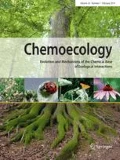Abstract
Previous research on Hypsipyla robusta revealed that females release and produce a three-component sex pheromone that consists of a 5:3:2 blend of (Z,E)-9,12-tetradecadienyl acetate (Z9E12-14:Ac), (Z)-9-tetradecenyl acetate (Z9-14:Ac) and (Z)-11-hexadecenyl acetate (Z11-16:Ac). However, the lure based on this formula was not effective or had no attraction to male H. robusta although used for monitoring H. robusta populations in the some field tests. We examined the sex pheromone active components of H. robusta in Guangdong, China. The pheromone gland extracts of female moths were analyzed by gas chromatography coupled with mass spectroscopy (GC–MS) and gas chromatography with electroantennographic detection (GC–EAD). GC–MS and GC–EAD analyses of courtship females (aerations) detected a new compound, (Z)-9-tetradecen-1-ol (Z9-14:OH). When Z9-14:OH was combined with Z9E12-14:Ac, Z9-14:Ac and Z11-16:Ac, the lures were attractive to male moths. The results suggested that Z9-14:OH was an important component in H. robusta female sex pheromone communication system. Adding Z9-14:OH to sex pheromone lure formulations would improve the efficacy of pheromone trap activity in China.





References
Beeson CFC (1919) The life history of the toon shoot and fruit borer, Hypsipyla robusta, Moore. (Lepidoptera; Pyralidae; Phycitinae) with suggestions for its control. Indian For Rec 7:146–261
Bellas T (2001) Semiochemicals of Hypsipyla shootborers. In: Floyd RB, Hauxwell C (eds) Hypsipyla shoot borers in Meliaceae. Proceedings of International Workshop held in Kandy, Sri Lanka, 20–23 Aug 1996. Australian Centre for International Agricultural Research, pp 116–117
Bosson GA, Gallois M (1982) Analysis of pheromonal secretion in virgin females of Hypsipyla robusta (Moore) (Lepidoptera, Pyralidae, Phycitinae) from young mahogany shoots. Comptes rendus des seances de l’Academie des Sciences Serie III Sciences de la Vie 294(16):819–822
Couilloud R, Guiol F (1980) Elévage en laboratoire d’Hypsipyla robusta (Moore) (Lepidoptera: Pyralidae). Bois et Forêts des Tropiques 194:35–47
Cunningham SA, Floyd RB (2004) Leaf compositional differences predict variation in Hypsipyla robusta damage to Toona ciliata in field trials. Can J For Res 34:642–648
Entwistle PF (1967) The current situation on shoot, fruit and collar borers of the Meliaceae. In: Proceedings of the 9th British Commonwealth Forestry Conference. Commonwealth Forestry Institute, Oxford
Fyfe LB, Patricia LB (2005) Growing Australian red cedar and other Meliaceae species in plantation. Rural Industries Research and Development Corporation, pp 15–17
Lopes JCA, Jennings SB, Matni NM (2008) Planting mahogany in canopy gaps created by commercial harvesting. For Ecol Manag 255:300–307
Ma T, Sun ZH, Li YZ, Wen XJ, Chen XY, Cao CL (2013a) Structural observation of head and chemoreceptors of Hypsipyla robusta larvae. North Hortic 24:119–122 (in Chinese)
Ma T, Yang XC, Sun ZH, Wen XJ, Li YZ, Chen XY (2013b) A simple method for identifying sex of pupae and adults of Hypsipyla robusta Moore. For Pest Dis 32(6):15–17 (in Chinese)
Ma T, Sun ZH, Li YZ, Wen XJ, Chen XY (2014) Emergence rhythm and reproduction behavior of Hypsipyla robusta (Lepidoptera: Pyralidae). J Fujian Agric For Univ 43:6–10 (in Chinese)
Mahroof RM, Hauxwell C, Edirisinghe JP, Watt AD, Newton AC (2002) Effects of artificial shade on attack by the mahogany shoot borer, Hypsipyla robusta (Moore). Agric For Entomol 4:283–292
McElfresh JS, Millar JG (1999) Geographic variation in sex pheromone blend of Hemileuca electra from Southern California. J Chem Ecol 25:2505–2525
Mo J, Tanton MT (1996) Diel activity patterns and the effects of wind on the mating success of red cedar tip moth, Hypsipya robusta Moore (Lepidoptera: Pyralidae). Aust For 59:42–45
Nakamuta K, Matsumoto K, Kotulai JR (2002) Field trapping of the mahogany shoot borer, Hypsipyla robusta (Lepidoptera: Pyralidae), with synthetic sex pheromone in Sabah, Malaysia. JIRCAS J 10:9–12
Newton AC, Baker P, Ramnarine S, Mesén JF, Leaky RRB (1993) The mahogany shoot-borer, prospects for control. For Ecol Manag 57:301–328
Opuni-Frimpong E, Karnosky DF, Storer AJ, Cobbinah JR (2008) Silvicultural systems for plantation mahogany in Africa: influences of canopy shade on tree growth and pest damage. For Ecol Manag 255:328–333
Su MW, Fang YL, Tao WQ, Yan GZ, Ma WE, Zhang ZN (2008) Identification and field evaluation of the sex pheromone of an invasive pest, the fall webworm Hyphantria cunea in China. Chin Sci Bull 53:555–560 (in Chinese)
Unbehend M, Hänniger S, Vásquez GM, Juárez ML, Reisig D, McNeil JN, Meagher RL, Jenkins DA, Heckel DG, Groot AT (2014) Geographic variation in sexual attraction of Spodoptera frugiperda corn- and rice-strain males to pheromone lures. PLoS One 9:1–11
Wang HL, Svensson GP, Rosenberg O, Bengtsson M, Jirle EV, Löfstedt C (2010) Identification of the sex pheromone of the spruce seed moth, Cydia strobilella L. J Chem Ecol 36:305–313
Yang CY, Han KS, Boo KS (2009) Sex pheromones and reproductive isolation of three species in genus Adoxophyes. J Chem Ecol 35:342–348
Acknowledgments
We heartily thank Dr. Zihong Fan (From United States) for her critical reading and useful suggestions. This research was supported by the National Natural Science Foundation (No. 31270692) and the Special Fund for forestry science and technology innovation of Guangdong, China (No. 2013KJCX015-02).
Author information
Authors and Affiliations
Corresponding authors
Additional information
Handling Editor: Günther Raspotnig.
Rights and permissions
About this article
Cite this article
Ma, T., Liu, Z., Lu, J. et al. A key compound: (Z)-9-tetradecen-1-ol as sex pheromone active component of Hypsipyla robusta (Lepidoptera: Pyralidae). Chemoecology 25, 325–330 (2015). https://doi.org/10.1007/s00049-015-0195-4
Received:
Accepted:
Published:
Issue Date:
DOI: https://doi.org/10.1007/s00049-015-0195-4

